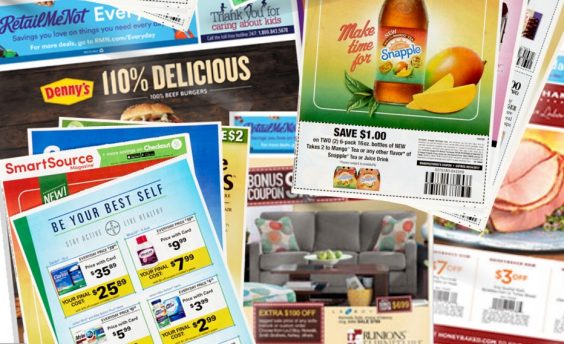
Is it a prescient prediction, or a clever ploy aimed at keeping his competitors off balance? Either way, the head of Coupons.com parent company Quotient Technology is doubling down on his declaration that there are tough times ahead for the newspaper coupon insert industry. Now, he’s suggesting that this could be the beginning of their end.
In a call with investors last week, Quotient CEO Steven Boal reiterated the statement he first made last fall about the future of coupon inserts, known in the industry as free-standing inserts, or FSIs. “We have been told,” he said, that companies “representing more than 20% of national coupons are expected to come out of the print FSI by the end of 2020.” Without naming names, he said those companies will no longer be offering coupons for their products in the Sunday inserts, and may be looking to redeploy their marketing dollars to Quotient’s digital offers instead.
This time, he took his prognostication a step further. Several major companies withdrawing from the Sunday coupon inserts, he said, will end up having a snowball effect that could impact the printed inserts’ very future.
“One of the things that happens when you start to change the dynamics of a vehicle like that is that others who are left in that vehicle are left sitting in a nonperforming asset,” Boal said of FSIs. “So they’re sitting with the dollar value of coupons in a product that isn’t being utilized anymore, because the aggregate value of that product has gone down. And so that sort of speeds up the process a little bit.”
In other words, fewer companies offering fewer coupons in the Sunday inserts could cause fewer consumers to seek out those inserts. As a result, the advertisers that remain, could find that their insert coupons aren’t having the same impact they once did – leading them, perhaps, to shift to digital-only offers as well.
That’s Boal’s prediction, at least. Competitors with a vested interest in coupon inserts, however, aren’t quite ready to declare them dead.
Valassis has been distributing coupon inserts for nearly half a century. “Our RetailMeNot Everyday coupon book provides quality over quantity in terms of circulation and reach,” a recent Valassis publication proclaims, pointing out that its inserts reach nearly 63 million U.S. households. Valassis even revved up its publication schedule this year, revealing plans to distribute inserts on 47 weeks of the year in 2020, up from just 38 weeks last year. “Brands continue to rely on the free-standing insert or FSI because consumers do, as well,” Valassis says.
According to the most recent figures from Inmar, 91.8% of all coupons in existence are distributed in the Sunday coupon inserts. Considering how many of those coupons go unused, it may seem like an inefficient system, but many brands find that inserts still represent the easiest and most cost-effective way to reach tens of millions of shoppers at once.
So coupon inserts’ future seems more secure than Boal suggests. Then again, that’s not to say there aren’t signs of trouble.
According to the latest figures available from Kantar, FSI promotion activity fell 12.4% in the first half of 2019, as compared to an 8.5% increase in digital offers. So the migration to digital that Boal is anticipating, already appears to be under way. And major companies dropping out of the inserts this year could accelerate that trend.
There’s also lingering uncertainty around the future of the other major coupon insert, SmartSource. After years of losses at SmartSource publisher News America Marketing, “driven by weakness in free-standing insert products,” according to owner News Corp, the company announced last summer that the News America division was up for sale.
“We’re engaged in active negotiations for the sale of the company, and I’m happy to report that those discussions are well advanced,” News Corp CEO Robert Thomson updated investors earlier this month. He didn’t let on who the potential buyer might be, but suggested that the SmartSource insert isn’t what a buyer would be most interested in. “Frankly, the company’s balance of revenues has shifted from being a newspaper insert company to being more of an in-store marketing company,” he said. “The latter is certainly a profitable business but not core to our competencies.”
So while some coupon insert publishers, and coupon providers that have no plans to exit the inserts, may look upon Boal’s prediction with some skepticism, there’s no doubt that Sunday inserts have seen better days. Predicting their demise may be premature, but there’s enough reason to believe that Boal may indeed be on to something.
This time next year, then, if your Sunday inserts seem a little slimmer, it may well be that what Boal said about companies abandoning the printed inserts, came true. Time will tell whether other companies step into the void and keep coupon inserts alive – or whether they follow the others’ lead, and turn the Sunday coupon insert into a relic.











It’s ironic that Steven Boal is predicting this demise, because while it may be happening, the publishers are not just turning to Coupons.com digital coupons, they are turning to ibotta for cash back offers that can be used multiple times in one transaction, which is what many consumers want anyway.
coupons one way or another will always be around–so will double coupons since more grocery stores offer those deals inc weiss–giant–h/t-martins-stop n shop-shoppers food-wegmans–safeway–and i probably left some out not on purpose–and dollar tree sells newspaper for a $1 even on weekends –Baltimore Sun is in DT on sat with coupons as well as sunday—–NOW: if you live in an area in which Rite-Aid is going to become WG–they have a 30% coupon you need to get before switching–then after WG takes over you have about 6 weeks to use it in that store–Not all R/A stores are switching.